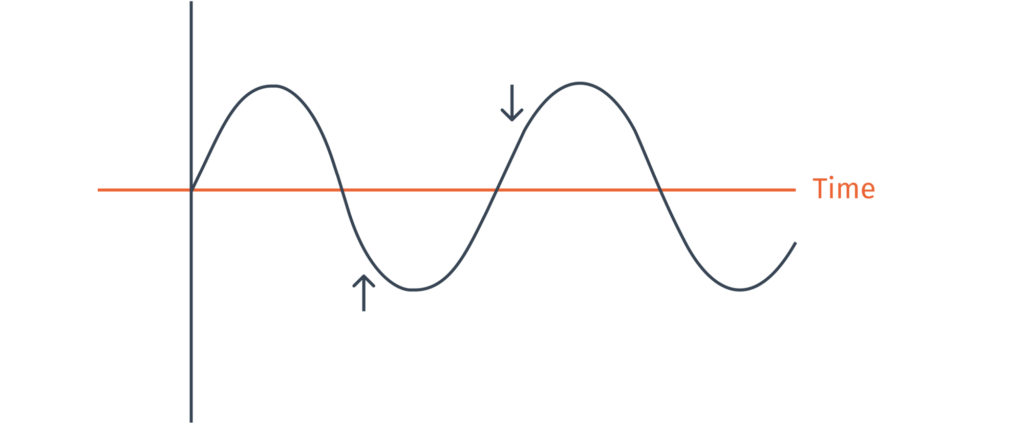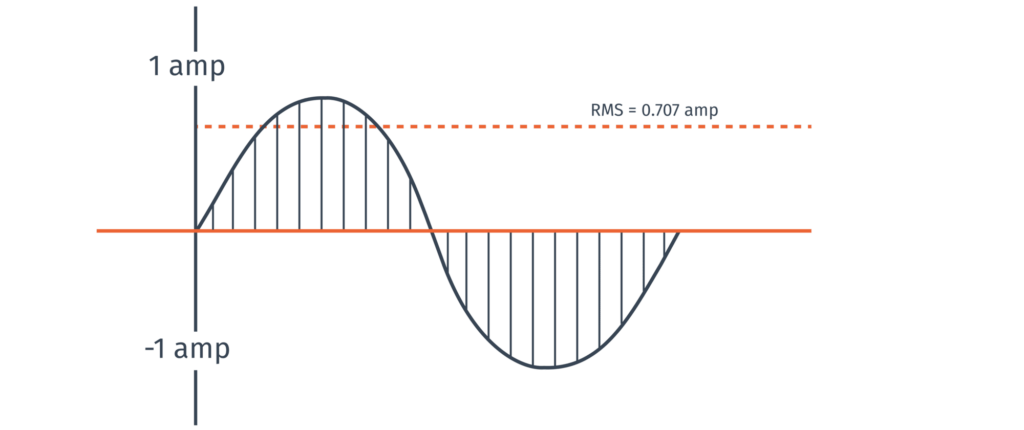
In order to answer the question “How do we measure electricity”, it is important to first understand what we are trying to measure. Given that electricity is just a form of energy, we could start with its most basic measurement, the joule.
The joule, named after James Prescott Joule, is equivalent to the amount of work it takes to accelerate a 1 kilogram object at 1 meter per second squared a distance of 1 meter. To all but the most technically minded, that description isn’t relatable. A more relatable way to describe it is the amount of energy it would take to lift a small apple (roughly 3.5 ounces) to a height of 1 meter. Isn’t that better? A joule is a pretty small amount of energy.
A joule is a measure of energy, and energy is just the capacity to do work, and if we measure electricity in joules we are simply measuring the total amount of work we can do with a given amount of electricity. Outside of scientific circles though, you aren’t likely to come across electricity measured in joules. No one ever opened their power bill and saw they used 3.2 billion joules of energy in the last month.
The Watt-hour
Instead, when you open your power bill, you see kilowatt-hours. Whenever you’re dealing with SI units, and you see “kilo” you know that it is a thousand of something. So in this case, a kilowatt-hour is a thousand watt-hours.
We tend to use kilowatt-hours because they result in smaller and more manageable numbers. For instance, we can say that an average household uses somewhere around 900 kilowatt-hours per month, instead of 900,000 watt-hours.
A watt-hour is equivalent to 3,600 joules, or the total energy in one watt continuously supplied over a period of one hour.
Energy is not Power
So now we know a watt-hour is a watt over the course of an hour, but why didn’t we start off by describing a watt first?
To answer that, I need to first talk a bit about energy vs power. Most people use the terms interchangeably, but they are distinct concepts. If we define energy as the total amount of work performed, then power is the rate at which the work is accomplished.
If we were to compare it to measuring speed and distance, then a watt would be similar to your speed in miles per hour, and a watt-hour would be the equivalent of the total number of miles driven. The naming of the units is a bit confusing, but the concept is straightforward.
And so a watt, named after James Watt, is a measure of power and not energy. It is equivalent to a joule per second, which is why a watt-hour is 3,600 joules (3,600 seconds in an hour). You’ll usually hear about the total amount of power that something is producing or consuming being measured in watts, because it is the measure of an amount of energy being consumed at a specific instant in time. For instance, you might hear about a power plant being described as producing 3 Gigawatts, meaning that its peak production at any given instant in time is 3 billion watts.
Apples Lifted to 1 Meter Per Second?
If a watt is equivalent to one joule per second, and a joule is the amount of work required to lift a small apple to one meter, then what does that make a watt? Is it the equivalent of one apple, lifted to one meter, per second? Yes, yes it is. But that isn’t a very useful comparison.
Instead, let’s look at some common items based on their power usage in watts:
1 watt = lcd clock
6 watts = electric toothbrush
100 watts = 65 inch LCD television
300 watts = blender
1,000 watts (1 kilowatt) = microwave
2,000 watts (2 kilowatts) = space heater
So the amount of power your microwave consumes is the equivalent of lifting 1000 3.5 oz apples, or about 218 pounds of apples, to a height of 1 meter every second it is running. Pretty impressive! Really puts it in perspective how much energy is being used to warm up your soup!
Measuring Electricity
Now that we have learned about joules, watts, and watt-hours I want to remind you of something. We can use these units to measure the energy of electricity, but they are just measures of energy and not specific to electricity.
We do have units that are specific to electricity though, and you’ve probably heard of the two most common… the amp and the volt.
An ampere (more commonly referred to as an amp, and named after André-Marie Ampère) is the measure of current, or the volume of electrical flow. So what exactly is an amp? 1 amp of current is defined as 6,241,509,074,000,000,000 (over 6.2 quintillion!) electrons passing by a given point in a second. That’s a lot of electrons!
When you see amps, you’ll usually see volts as well. A volt (named after Alessandro Volta) is the measure of the “electric potential difference”, or to put it more simply (and somewhat inaccurately), how fast electrons are traveling.
A helpful analogy is that if you think of electricity as water flowing through a pipe, amps are how big the pipe is, whereas volts are a measure of the water pressure (technically the difference in pressure between two points).
To double down on this somewhat inaccurate analogy: a very small pipe (low amperage) with high water pressure (high voltage) still won’t pass as much electricity as a really large pipe (high amperage) with a lower voltage (low water pressure).
To calculate the electric power something consumes or produces is therefore simply a product of its voltage and amperage:
Power (Watts) = Volts * Amps
So if we know that in the United States we primarily run our electricity at 120 volts, and we wanted to calculate how many amps our 1000 watt microwave in the earlier example was consuming, all we have to do is divide the watts by 120. This will tell us that a 1000 watt microwave consumes about 8.3 amps. A house in the United States is typically fed either 100 amps or 200 amps, so that is a significant portion of the total electricity able to be supplied to your home.
Alternating current is a little more complicated
If you’re only concerned with things that consume DC (direct current), then you can probably stop here and be perfectly fine. But if you’re talking about the electric grid, or dealing with things measuring AC (alternating current) then you’ll often see a unit of power called the volt-ampere (abbreviated VA).
In an AC circuit the voltage and current are constantly oscillating. So if we measure them at random points in time they can be at different points in that oscillation.

Because of this, the volt-ampere is defined as the root mean square (RMS) of the voltage times the RMS of the amperage. The RMS is a type of average used in AC circuits, so when you see a value like “120 volts” then you know it is actually an RMS value since the voltage is constantly changing.
RMS is just a way of calculating the equivalent steady-state voltage from an oscillating wave, so if we had a wave oscillating between -1 amp and 1 amp, then using the RMS calculation we would get the equivalent steady state voltage equivalent of 0.707 amps.

Based on that, we define a volt-ampere as:
Volt-ampere = RMS Volts * RMS Amps
That looks pretty much the same as the way we defined watts above, right? Exactly. And in fact, in a DC circuit where the current and voltage are not oscillating a watt and a volt-ampere would be equivalent. It is only in an AC circuit where the distinction becomes important.
In an AC circuit where we have an oscillating voltage and amperage, when we introduce any components that store energy in magnetic or electric fields the voltage and amperage get out of phase for reasons we aren’t going to discuss here. When this happens the current is said to be leading or lagging. The types of components that cause this are things like generators, electric motors, capacitors, electromagnets, and even conductors.
When these types of components are present in the circuit, there is power that is needed to maintain the magnetic or electric fields. This power is known as reactive power. This reactive power doesn’t go directly toward doing work, and so you end up with a situation where the amount of power doing work isn’t equal to the total amount of power in the circuit. So you end up with three components of the power:
Real power – watts – the amount of power actually doing work.
Reactive power – volt-ampere reactive (abbreviated VAR) – the power used to maintain the magnetic and electric fields of an inductive (magnetic field) or capacitive (electric field) load.
Apparent power – volt-ampere (abbreviated VA) – basically the total of the real and reactive power on the circuit. This is the total amount of power that the circuit has to handle, even though only the real power is actually consumed by the load.
The ratio of real power to apparent power is known as the power factor. The power company has to supply both the real power and reactive power, even though when you see your bill you’re only seeing the real power (power consumed).
Here Comes Batteries
When you look at a battery, you’ll usually see them measured in amp-hours (ampere-hours). Amp-hours are exactly what they sound like, it is equivalent to a single amp delivered continuously over an hour.
Oddly though, amp-hours don’t really tell you about the capacity of a battery, you need to know the voltage of the battery to calculate the capacity.
So why don’t batteries just use watt-hours to show capacity directly? Why do we need yet another unit? The truth is that we could use watt-hours to specify battery capacity, and in fact you’ll notice that some batteries (and many electric cars) do just that. They use some nominal voltage and the amp-hours of the battery to calculate a capacity in kilowatt-hours.
But typically when dealing with battery powered devices you need to match the battery to the voltage and the amps of the device. Watt-hours would tell you the capacity of the battery, but wouldn’t tell you anything about the voltage or the amps the battery can supply. So you need to have a bit more information about the battery to match it to the device.
Also, when you’re working with battery powered electronics you’ll need to understand how long a given battery will power a given device. If you have a device that consumes 1 amp at 12 volts then you know that a 12-volt 3 amp-hour battery battery will power that device for roughly 3 hours. Add a second battery and you know that you doubled the amount of time that a device will run. Using amp-hours makes these calculations significantly more simple.
Wrap Up
If you made it this far, congratulations. While electricity is one of the most important parts of our modern world, our measurement of it can be a bit confounding. I hope this post cleared up a bit of the mystery, and I want to leave you with this handy list in case you’re looking for something to reference easily.
- Joule – a measure of energy roughly equivalent to lifting a 3.5oz object to a height of one meter
- Watt – W – a measure of power equal to one joule per second
- Watt-hour – Wh – a measure of energy equivalent to one watt of power delivered continuously over an hour
- Amp-hour – Ah – a measure of charge equivalent to one amp delivered continuously over one hour
- Volt – V – a measure of the “electric potential difference” or the speed at which electricity flows
- Amp – A – a measure of current, or the volume of electrical flow
- Volt-ampere – VA – a measure of apparent power, or the combination of real power and reactive power
- Volt-ampere reactive – VAR – a measure of reactive power, or power used to maintain the magnet or electric fields in certain types of loads
Loved the article? Hated it? Didn’t even read it?
We’d love to hear from you.


Electricity is measured using various instruments such as voltmeters, ammeters, and wattmeters. Recent scientific research has focused on developing new methods for more accurate and efficient measurement of electrical power. One such innovation is the use of micro-electromechanical systems (MEMS) sensors, which enable highly precise and low-cost monitoring of electrical energy consumption in real-time. This technology could revolutionize the way we measure and manage electricity in the future
If you made it this far, congratulations. While electricity is one of the most important parts of our modern world, our measurement of it can be a bit confounding. I hope this post cleared up a bit of the mystery, and I want to leave you with this handy list in case you’re looking for something to reference easily.
Great post! I never knew there were so many ways to measure electricity. The simple thread method is particularly interesting. Can you elaborate on how it works?
Real-world application: Calculating appliance energy consumption
The post does a fantastic job explaining the various units used to measure electricity. But how can we use this knowledge in everyday life? Here’s a practical example:
Let’s say you want to calculate the monthly electricity cost of running a space heater.
Identify the heater’s power rating: Most appliances have a label mentioning wattage (W). Let’s assume your space heater is rated at 1500 W.
Estimate daily usage: Think about how many hours you typically use the heater each day. For example, maybe you use it for 2 hours daily.
Convert hours to kilowatt-hours (kWh): Daily usage (hours) x Appliance wattage (W) / 1000 = Daily kWh consumption. In this case, 2 hours * 1500 W / 1000 = 3 kWh.
Multiply by monthly usage days: Daily kWh consumption * Number of days you use the heater in a month = Monthly kWh consumption. Assuming you use it for 30 days, this would be 3 kWh/day * 30 days = 90 kWh.
Check your electricity bill: Find the rate you’re charged per kWh. Let’s say it’s $0.10/kWh.
Calculate the monthly cost: Monthly kWh consumption * Electricity rate = Monthly cost. So, the estimated monthly cost would be 90 kWh * $0.10/kWh = $9.
By understanding watts, hours, and kilowatt-hours, you can make informed decisions about your appliance usage and estimate electricity costs.
Here’s how to figure out your space heater’s monthly electricity cost:
Find Power Rating: Check the heater’s label for its wattage. Example: 1500 W.
Estimate Daily Use: Suppose you use it for 2 hours daily.
Calculate Daily kWh: (Hours x Wattage) / 1000. So, 2 hours * 1500 W / 1000 = 3 kWh per day.
Find Monthly kWh: Daily kWh * Days Used. For 30 days, 3 kWh/day * 30 = 90 kWh.
Check Your Rate: Find your electricity cost per kWh. Example: $0.10/kWh.
Calculate Monthly Cost: Monthly kWh * Rate. Thus, 90 kWh * $0.10 = $9.
Using these steps helps you estimate your appliance’s energy costs accurately.
Further, If you wish, you can check your FESCO electricity bill at https://fscobill.pk
To understand how we measure electricity, it’s important to first know the basics. Electricity is a form of energy, and the fundamental unit to measure energy is the joule. For practical purposes, when it comes to measuring electricity usage in homes, we use kilowatt-hours. One kilowatt-hour (kWh) is the equivalent of 1,000 watt-hours, and a watt-hour equals 3,600 joules. The distinction between energy and power is crucial here: energy refers to the total amount of work done, while power is the rate at which energy is consumed or generated. Watts measure power, while amps and volts define the current and electrical potential, respectively. Further, If you wish, you can check your FESCO electricity bill at https://fescoebilling.pk/